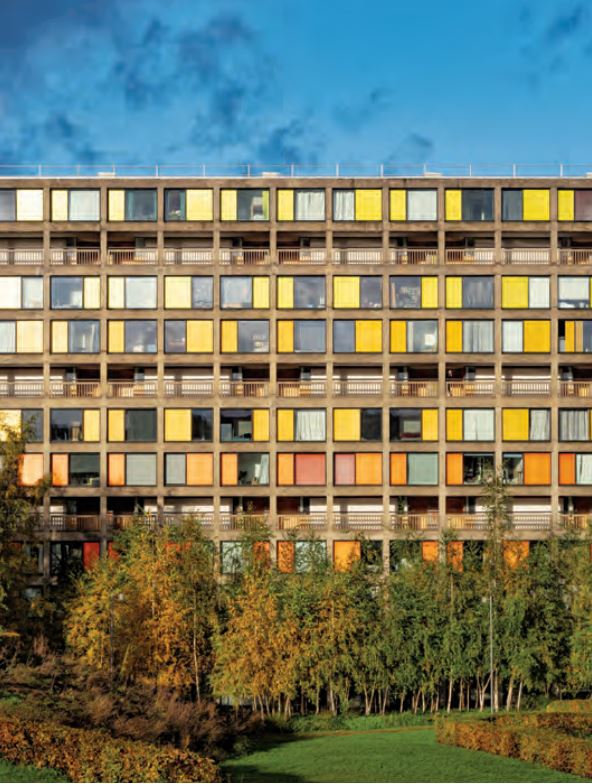Outstanding Contribution
Outstanding Contribution Winner: Urban Splash
For the first time the Architecture Today Awards jury issued an award for Outstanding Contribution, in recognition of developer Urban Splash’s pioneering work in recognising the value in existing buildings and designing new buildings that will stand test the time.
Founded in 1993 by chairman Tom Bloxham and creative director Jonathan Falkingham, Urban Splash made its name by breathing new life into redundant historic buildings first in Liverpool and Manchester and subsequently across the UK.
Challenging perceived wisdom that historic buildings were too difficult and costly to convert to modern use, Urban Splash converted historic – often listed – buildings into affordable, and wildly popular, residential and commercial space, re-establishing deserted city centres as desirable places to live and work
Over the last 30 years, it has delivered some 60 regeneration projects, including two winners in the Architecture Today Awards. Studio Egret West and Hawkins\Brown’s 2013 reinvention of Park Hill, Sheffield, won the Residential category in the 2023 awards, while Timber Wharf, completed by Howells and Urban Splash in 2002, won the Residential category in the 2023 awards for showing how the core values of flexibility, longevity and adaptability have been applied to the company’s first new-build scheme.
The Architecture Today jury said “Way ahead of its time, Urban Splash has moved the dial by demonstrating – again and again – that responsible development can deliver critical acclaim and commercial success.”
Urban Splash receive their Outstanding Contribution award. From left to right: AT editor Isabel Allen, Jonathan Falkingham and Tom Bloxham from Urban Splash, and AT publishing director Jonathan Stock.
Urban Splash co-founder Tom Bloxham reflects on the birth of the company and adopting the same approach to place-making as the citizens of ancient Athens
When I set up Urban Splash 32 years ago, there were a number of different things going on. One is that I arrived in Manchester and there were these amazing buildings that were lying empty. The property industry said that they’d never let. I thought they were great buildings, and I just didn’t believe that. The second thing was there were a load of people, friends of mine, who were entrepreneurs and who wanted office space or retail space, and they couldn’t get any because the property industry didn’t serve them. Unless you were long established with big accounts, you couldn’t rent a shop or an office. For a small creative industry it was very hard to find good quality space.
Then I met Jonathan Falkingham, who was an architect who had recently graduated. He had great design skills and I think he felt a bit frustrated with most of his clients and fancied being his own client and doing something more interesting. So it was this combination of catering for forward-thinking individuals and businesses, using great contemporary design, and saving old buildings. And it was a great economic opportunity because you could buy buildings at the same price as carpets. So what could possibly go wrong?
And then there was the challenge of changing people’s perceptions. People forget that there was nobody living in Manchester city centre. You couldn’t buy milk or a loaf of bread. So it was actually recreating it. But we had been to New York. We’d been to London obviously, and Paris, and all the other cities and we were convinced that it was an anomaly with English northern cities, that they were so unfriendly.
The 2013 regeneration of Park Hill, Sheffield, by Studio Egret West and Hawkins\Brown, was a winner in the 2023 Architecture Today Awards.
When we did our first scheme, Concert Square in Liverpool, we sold out. It was very well designed. It was economical. It was affordable for many people. We sold it all ourselves in-house. We, the architects, actually meeting the customers and selling the flats. And we sold everything straight away.
I think it’s much harder for people to start out today. I mean, it wasn’t easy for us to start 32 years ago. But the first scheme we did, we did the planning ourselves and I think it probably cost us about 20 grand. We got it in three months. We were on site straight away and we were literally going to IKEA to buy the kitchens. We were taking joiners off the streets. It was so much easier.
The same project today, I’m guessing would take 18 months or two years, and probably cost £300,000 to get planning. I think the whole way we build buildings has got so much more complicated. There are so many regulations. So many more people with views. And I’m not convinced that we’re actually producing better buildings for it.
I think everybody was just so surprised and relieved that we were actually saving some buildings. I think almost universally it was appreciated. Some of our interventions were really quite radical.
The Collegiate was one of our early projects in Liverpool. It was a Grade II listed school designed in 1843. Harvey Lonsdale was the original architect, a very important architect. And there in the end we just did a façade retention and even changed the windows. But we were working with Historic England. And to be fair to them, they understood the constraints we had, particularly around value and the difficulties of the buildings. As long as we articulated the arguments of why we were making changes, they were just super supportive that we were showing that these buildings did have a modern future and you could use them. They weren’t precious at all. Actually, I would describe them as very open and very cooperative.
From day one, we referred to the oath sworn by the citizens of ancient Athens, and we still use it today: “We will leave this place not less, but greater, better and more beautiful than it was left to us.” In a way that’s our ESG policy there. That’s what we always try and do. To make a positive impact on the world.
Reduce, reuse and only then recycle. And then build new and throw away. The reusing is super important. Why would you knock a building down when you could keep it? Initially, at least, it was cheaper to reuse buildings and keep hold of the structure. And there’s the embodied carbon. The whole idea that historic buildings might be written off because they have low EPCs is just bonkers to me. You’re going to force people to knock them down and rebuild them. That’s crazy. Yes, some of the old buildings may be less well insulated than modern buildings, but actually as the grid goes green, the environmental cost will reduce.
I think we want to start a much wider debate about what sustainability really means. I get sick and tired of seeing these super sustainable buildings which are in the middle of the countryside where you need a car to get to them. For me, buildings that reuse materials and are in city centres near transport hubs are much more important for me than the airtightness of an individual building.
Timber Wharf, Castlefield, designed with Howells, won the residential category in the 2024 Architecture Today Awards.
Part of the brief for Timber Wharf was, “let’s build a building, which people will be proud of, and which they’ll want to save in 100 years time.” We wanted to apply the lessons that we’ve learnt from restoring beautiful old buildings. And the other thing we’ve learnt is that actually being rational is efficient and efficient allows you to be affordable. So the walls are bare concrete walls. It’s a bit more expensive to get a really good finish, but it’s saved us a cost of plastering.
I’m not interested in decoration. And I’m not interested in fashion. I actually dislike fashion, I’m interested in design, and great design lasts forever. Like the Victorians, I want to build buildings that last forever. Buildings that are honest, that are straightforward, that stand the test of time.
Our awards sponsors













